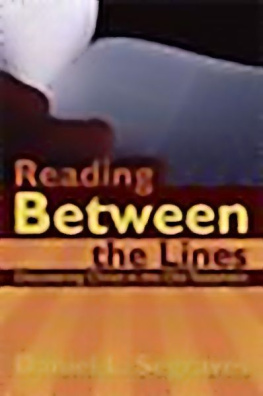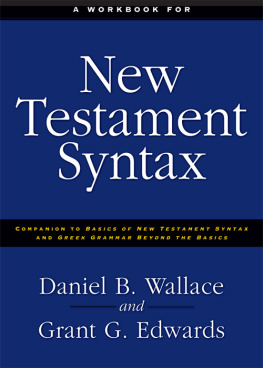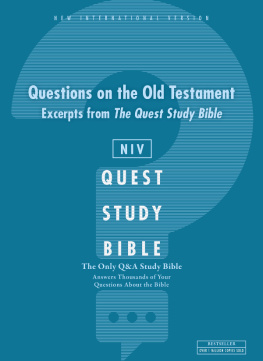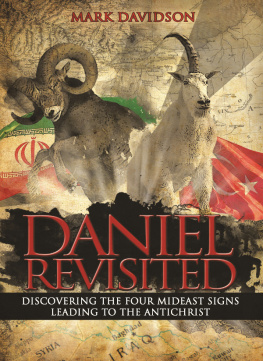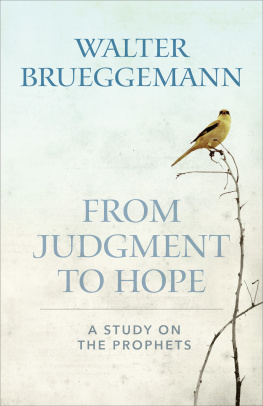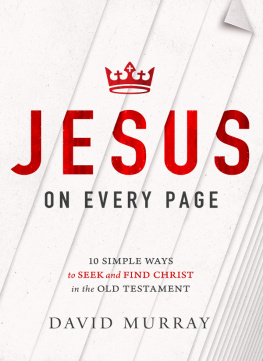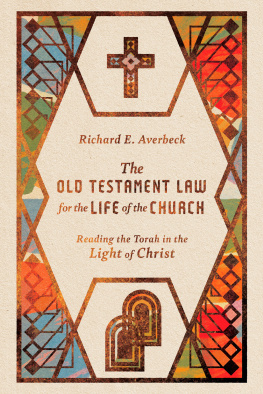Daniel L Segraves - Reading Between the Lines: Discovering Christ in the Old Testament
Here you can read online Daniel L Segraves - Reading Between the Lines: Discovering Christ in the Old Testament full text of the book (entire story) in english for free. Download pdf and epub, get meaning, cover and reviews about this ebook. year: 2008, publisher: Word Aflame Press, genre: Religion. Description of the work, (preface) as well as reviews are available. Best literature library LitArk.com created for fans of good reading and offers a wide selection of genres:
Romance novel
Science fiction
Adventure
Detective
Science
History
Home and family
Prose
Art
Politics
Computer
Non-fiction
Religion
Business
Children
Humor
Choose a favorite category and find really read worthwhile books. Enjoy immersion in the world of imagination, feel the emotions of the characters or learn something new for yourself, make an fascinating discovery.
- Book:Reading Between the Lines: Discovering Christ in the Old Testament
- Author:
- Publisher:Word Aflame Press
- Genre:
- Year:2008
- Rating:4 / 5
- Favourites:Add to favourites
- Your mark:
- 80
- 1
- 2
- 3
- 4
- 5
Reading Between the Lines: Discovering Christ in the Old Testament: summary, description and annotation
We offer to read an annotation, description, summary or preface (depends on what the author of the book "Reading Between the Lines: Discovering Christ in the Old Testament" wrote himself). If you haven't found the necessary information about the book — write in the comments, we will try to find it.
Reading Between the Lines: Discovering Christ in the Old Testament — read online for free the complete book (whole text) full work
Below is the text of the book, divided by pages. System saving the place of the last page read, allows you to conveniently read the book "Reading Between the Lines: Discovering Christ in the Old Testament" online for free, without having to search again every time where you left off. Put a bookmark, and you can go to the page where you finished reading at any time.
Font size:
Interval:
Bookmark:
Unless otherwise indicated, all quotations of Scripture are from The Holy Bible, New King James Version, copyright 1984 by Thomas Nelson, Inc.
All rights reserved. No portion of this publication may be reproduced, stored in an electronic system, or transmitted in any form or by any means, electronic, mechanical, photocopy, recording, or otherwise, without the prior permission of Daniel L. Segraves. Brief quotations may be used in literary reviews.
Printed in United States of America
Printed by Word Aflame Press

Library of Congress Cataloging-in-Publication Data

In order to discover what the Old Testamentthe Hebrew Scripturehas to say about Jesus, we must learn to be alert to references to the Old Testament as they are found in the New Testament. Phrases like as it is written or references to the prophets are the kinds of clues for which we should look. Many study Bibles are helpful because they set off quotes from the Old Testament in a different typeface, with indents, or by some other visual indication. Although these techniques are useful, we should not rely on them to give us an exhaustive list of the references to the Old Testament in the New Testament, because the nearly eight hundred references to the Hebrew Bible in the New Testament are not always in the form of complete quotes. These references include paraphrases and allusions, which may not be indicated by typical introductory language such as it is written or by typographical techniques. To be sure we are aware of every use the New Testament makes of the Old Testament, there is no substitute for simply reading the text carefully.
If we wish to explore the messianic content of the Old Testament, it is important we be aware of something called innertextuality and intertextuality. These terms refer to the use Scripture makes of Scripture. We have discussed the use of the Old Testament in the New Testament. This is intertextuality. In other words, intertextuality has to do with how those who wrote Scripture quoted or referred to other Scriptures that had already been written. Often intertextuality helps us interpret Scripture. The way later authors referred to earlier authors is interpretive. For example, on the Day of Pentecost, after the Holy Spirit was poured out on the waiting believers, and in response to the question, Whatever could this mean? (Acts 2:12), Peter answered, This is what was spoken by the prophet Joel (Acts 2:16). Then Peter quoted Joel 2:28-32, indicating that Joel had anticipated the events of the Day of Pentecost. Then, as recorded in Acts 2:25-28, Peter quoted from Psalm 16:8-11 to declare that David wrote of Jesus Christ. These are examples of a form of intertextuality.
But there is also innertextuality, which refers to a biblical author referring back to something already written in an earlier part of the same book. For example, Psalm 1, which is part of the introduction to the Book of Psalms, describes a contrast between the righteous and the wicked. This contrast forms a major part of the structure of the Psalter, and it is referred to again and again in the following psalms. Each time there is a reference to the righteous and the wicked, it is rooted in Psalm 1, further explaining and developing the contrast between the two.
For our purposes, we want to look at an example of intertextuality in the Bible. When we do this, it is important to read the Bible carefully, being alert to the appearance of phrases that are similar to phrases that appear elsewhere in Scripture. Since Jesus opened the Scripture to the two disciples on the road to Emmaus by starting with the first book of the Bible, lets do the same.
The first verse of the Bible, Genesis 1:1, reads, In the beginning God created the heavens and the earth. The phrase in the beginning immediately reminds us of another place in the Bible where these same words appear. The apostle John wrote, In the beginning was the Word, and the Word was with God, and the Word was God. The same was in the beginning with God (John 1:12, KJV). Not only did John twice use the phrase in the beginningthe same phrase that appears in the first verse of the Bible, but he was also discussing the same subject: Creation. John wrote, All things were made by him; and without him was not anything made that was made (John 1:3, KJV).
But this is not the only time John referred to the beginning. In the opening verses of his first letter, just as in the Gospel of John 1:1-2, John wrote of the beginning: That which was from the beginning, which we have heard, which we have seen with our eyes, which we have looked upon, and our hands have handled, concerning the Word of lifethe life was manifested, and we have seen, and bear witness, and declare to you that eternal life which was with the Father and was manifested to us. The similarities between John 1:1-2 and I John 1:1-2 are remarkable. In both places, John referred to the beginning and to the Word. And there is a further connection between these two texts: In John 1:14, John wrote that the Word became flesh and dwelt among us, and we beheld His glory, the glory as of the only begotten of the Father, full of grace and truth. This is, of course, a reference to Jesus Christ, the Word made flesh. In his first letter, John discussed the same subject in similar words: the life was manifested, and we have seen, and bear witness, and declare to you that eternal life which was with the Father and was manifested to us (I John 1:2). In his Gospel, John wrote that the Word became flesh; in his first letter, he wrote that the Word of life was manifested in such a way as to be seen and handled. This is certainly an example of intertextuality, and we will look at it again to see what it tells us about Jesus.
But we should note that there is yet another use of the phrase in the beginning in the New Testament with an apparent connection with Genesis 1:1. In Hebrews 1, several verses are quoted from the Old Testament to show that Jesus is superior to the angels. These references include Psalm 2:7, II Samuel 7:14, Deuteronomy 32:43, Psalm 104:4, and Psalm 45:6-7. Then, in Hebrews 1:10-12, we find a quote from the Old Testament that uses the phrase in the beginning in a reference to creation, just as in Genesis 1:1. It reads, And: You LORD, in the beginning laid the foundation of the earth, and the heavens are the work of Your hands. They will perish, but You remain; and they will all grow old like a garment; like a cloak You will fold them up, and they will be changed. But You are the same, and Your years will not fail. This quote from Psalm 102:25-27 is quite interesting because it is a reference in the New Testament to a Scripture in the Old Testament that is itself a reference to an earlier Scripture. This is certainly an excellent example of intertextuality.
How do these Scriptures help us know Jesus more fully? When we examine them carefully, we can see that the New Testament references to Genesis 1:1 serve to identify Jesus Christ as the God who created the heavens and the earth. The word translated God in Genesis 1:1 is the Hebrew, Elohim. Although this word is plural in form, it is singular in reference. In the Hebrew language, plural words are used not only to indicate more than one of something, but also to indicate intensity or fullness of a singular referent. One way we determine whether the noun Elohim refers to a singular or plural referent is to note whether the verb used with this noun is singular or plural. In the Hebrew language, singular nouns have singular verbs, and plural nouns ordinarily have plural verbs. But if a plural noun is accompanied by a singular verb, the noun must be read as singular. In Genesis 1:1, the plural
Next pageFont size:
Interval:
Bookmark:
Similar books «Reading Between the Lines: Discovering Christ in the Old Testament»
Look at similar books to Reading Between the Lines: Discovering Christ in the Old Testament. We have selected literature similar in name and meaning in the hope of providing readers with more options to find new, interesting, not yet read works.
Discussion, reviews of the book Reading Between the Lines: Discovering Christ in the Old Testament and just readers' own opinions. Leave your comments, write what you think about the work, its meaning or the main characters. Specify what exactly you liked and what you didn't like, and why you think so.

